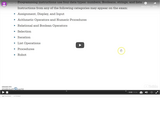
Interactive video reviewing essential knowledge for the AP CS Exam.
- Subject:
- Applied Science
- Computer Science
- Material Type:
- Interactive
- Provider:
- Michigan Virtual
- Date Added:
- 12/11/2018

Interactive video reviewing essential knowledge for the AP CS Exam.
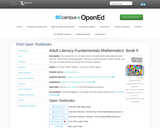
: Fundamental mathematics for adult learners. Book 5 includes a Table of Contents, Glossary, Grades Records, Self Tests, Practice Tests and Unit Tests. Ancillary Resources include the Instructor's Manual. This is 1 of a series of 6 books in the ABE Math collection.
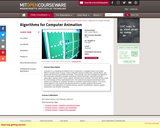
In-depth study of an active research topic in computer graphics. Topics change each term. Readings from the literature, student presentations, short assignments, and a programming project. Animation is a compelling and effective form of expression; it engages viewers and makes difficult concepts easier to grasp. Today's animation industry creates films, special effects, and games with stunning visual detail and quality. This graduate class will investigate the algorithms that make these animations possible: keyframing, inverse kinematics, physical simulation, optimization, optimal control, motion capture, and data-driven methods. Our study will also reveal the shortcomings of these sophisticated tools. The students will propose improvements and explore new methods for computer animation in semester-long research projects. The course should appeal to both students with general interest in computer graphics and students interested in new applications of machine learning, robotics, biomechanics, physics, applied mathematics and scientific computing.
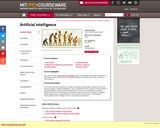
This course introduces students to the basic knowledge representation, problem solving, and learning methods of artificial intelligence. Upon completion of 6.034, students should be able to develop intelligent systems by assembling solutions to concrete computational problems, understand the role of knowledge representation, problem solving, and learning in intelligent-system engineering, and appreciate the role of problem solving, vision, and language in understanding human intelligence from a computational perspective.

Tony Sarg was a puppeteer and marionette master who invented the first, larger than life, helium balloons for the annual Macy’s Thanksgiving Day Parade. The resource includes a lesson plan/book card, a design challenge, and copy of a design thinking journal that provide guidance on using the book to inspire students' curiosity for design thinking. Maker Challenges include: (1) Dash/Sphero: Develop a Macy’s Day Parade route using tape on the ground with a partner. Then, switch routes with another group and program the robot of your choice to navigate the parade route using code. (2) Ozobot: Develop a synchronized dance routine for both Ozobots for the stage of the Macy’s day parade using https://ozoblockly.com/editor (3) Create a moveable puppet that will be featured in the Macy’s Day Parade.
A document is included in the resources folder that lists the complete standards-alignment for this book activity.
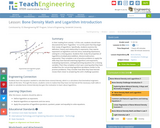
In their reading from activity 1 of this unit, students should have discovered the term "logarithm." It is at this point that they begin their study of logarithms. Specifically, students examine the definition, history and relationship to exponents; they rewrite exponents as logarithms and vice versa, evaluating expressions, solving for a missing piece. Students then study the properties of logarithms (multiplication/addition, division/subtraction, exponents). They complete a set of practice problems to apply the skills they have learned (rewriting logarithms and exponents, evaluating expressions, solving/examining equations for a missing variable.) Then they complete a short quiz covering what they have studied thus far concerning logarithms (problems similar to the practice problems). They consider how what they have learned moves them closer to answering the unit's challenge question.
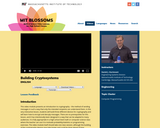
This video module presents an introduction to cryptography - the method of sending messages in such a way that only the intended recipients can understand them. In this very interactive lesson, students will build three different devices for cryptography and will learn how to encrypt and decrypt messages. There are no prerequisites for this lesson, and it has intentionally been designed in a way that can be adapted to many audiences. It is fully appropriate in a high school level math or computer science class where the teacher can use it to motivate probability/statistics or programming exercises. nteractive lesson, students will learn to build the cryptography devices and will learn how to send and ''crack'' secret messages.
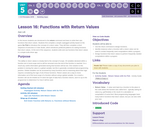
In this lesson students are introduced to the **return** command and learn to write their own functions that return values. Students first complete a simple unplugged activity based on the game **Go Fish** to introduce the concept of a return value. They will then complete a short sequence of exercises in Code Studio, which introduces preferred patterns for writing functions that return values. At the end of the sequence, students write and use functions that return values in a simple turtle driver app.

Students continue learning about Event Driven programming in this lesson by learning how to add multiple "screens" to an app and adding code to switch between them. More techniques of debugging are presented, namely using `console.log`, a command that allows them to print out text which the user cannot see. It is useful for displaying messages to yourself to figure out what is happening as your program runs. Students will end the lesson by creating an improved version of the “chaser” game which has multiple screens.
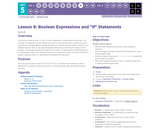
In this lesson, students write `if` and `if-else` statements in JavaScript for the first time. The concepts of conditional execution should carry over from the previous lesson, leaving this lesson to get into the nitty gritty details of writing working code. Students will write code in a series of "toy" problems setup for them in App Lab that require students to do everything from debug common problems, write simple programs that output to the console, or implement the conditional logic into an existing app or game, like "Password Checker" or a simple Dice Game. The lesson ends with a problem requiring nested `if` statements to foreshadow the next lesson.
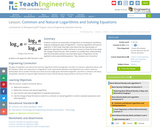
Students continue an examination of logarithms in the Research and Revise stage by studying two types of logarithms—common logarithms and natural logarithm. In this study, they take notes about the two special types of logarithms, why they are useful, and how to convert to these forms by using the change of base formula. Then students see how these types of logarithms can be applied to solve exponential equations. They compute a set of practice problems and apply the skills learned in class.

Students will recognize that computer science is so important because it can be found in almost every career. Don't wait, start learning how to code today.

This is a fast-paced introductory course to the C++ programming language. It is intended for those with little programming background, though prior programming experience will make it easier, and those with previous experience will still learn C++-specific constructs and concepts. This course is offered during the Independent Activities Period (IAP), which is a special 4-week term at MIT that runs from the first week of January until the end of the month.
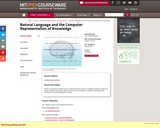
Relationship between computer representation of knowledge and the structure of natural language. Emphasizes development of the analytical skills necessary to judge the computational implications of grammatical formalisms, and uses concrete examples to illustrate particular computational issues. Efficient parsing algorithms for context-free grammars; augmented transition network grammars. Question answering systems. Extensive laboratory work on building natural language processing systems. 6.863 is a laboratory-oriented course on the theory and practice of building computer systems for human language processing, with an emphasis on the linguistic, cognitive, and engineering foundations for understanding their design.
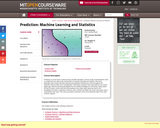
Prediction is at the heart of almost every scientific discipline, and the study of generalization (that is, prediction) from data is the central topic of machine learning and statistics, and more generally, data mining. Machine learning and statistical methods are used throughout the scientific world for their use in handling the "information overload" that characterizes our current digital age. Machine learning developed from the artificial intelligence community, mainly within the last 30 years, at the same time that statistics has made major advances due to the availability of modern computing. However, parts of these two fields aim at the same goal, that is, of prediction from data. This course provides a selection of the most important topics from both of these subjects.
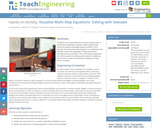
Students use a simple seesaw to visualize solving a two- or three-step mathematics equation, while solving a basic structural engineering weight balance problem in the process. They solve two-step equations on a worksheet and attempt to solve the challenge of "balancing a beam" through hands-on problems. The use of sensor equipment for correct position monitoring aids students in balancing the structure, as well as balancing the equation as they solve it on paper.